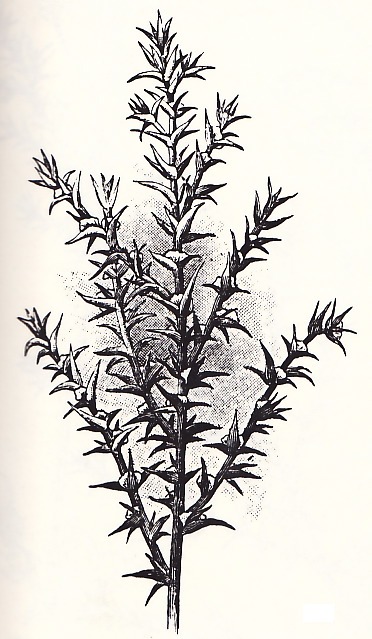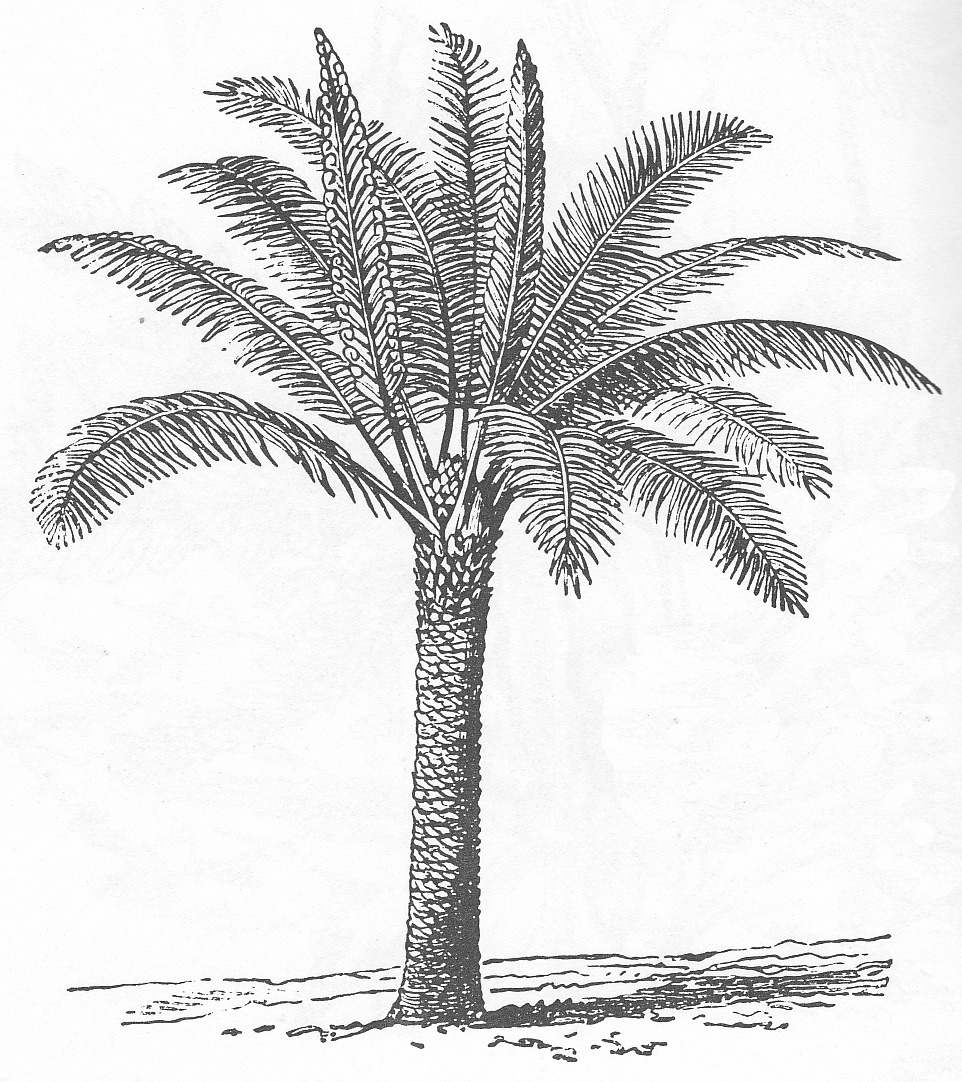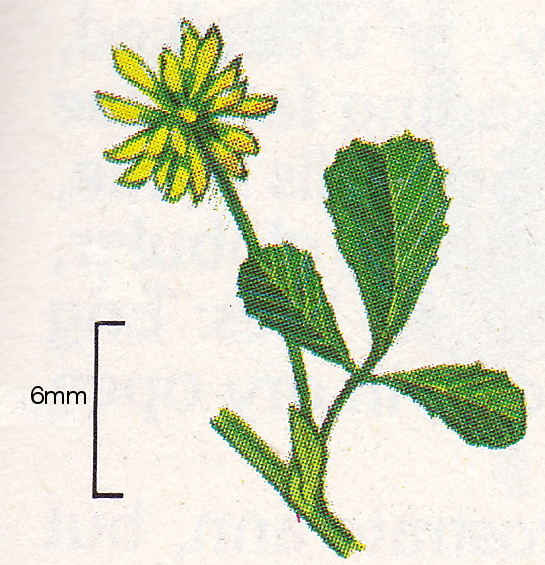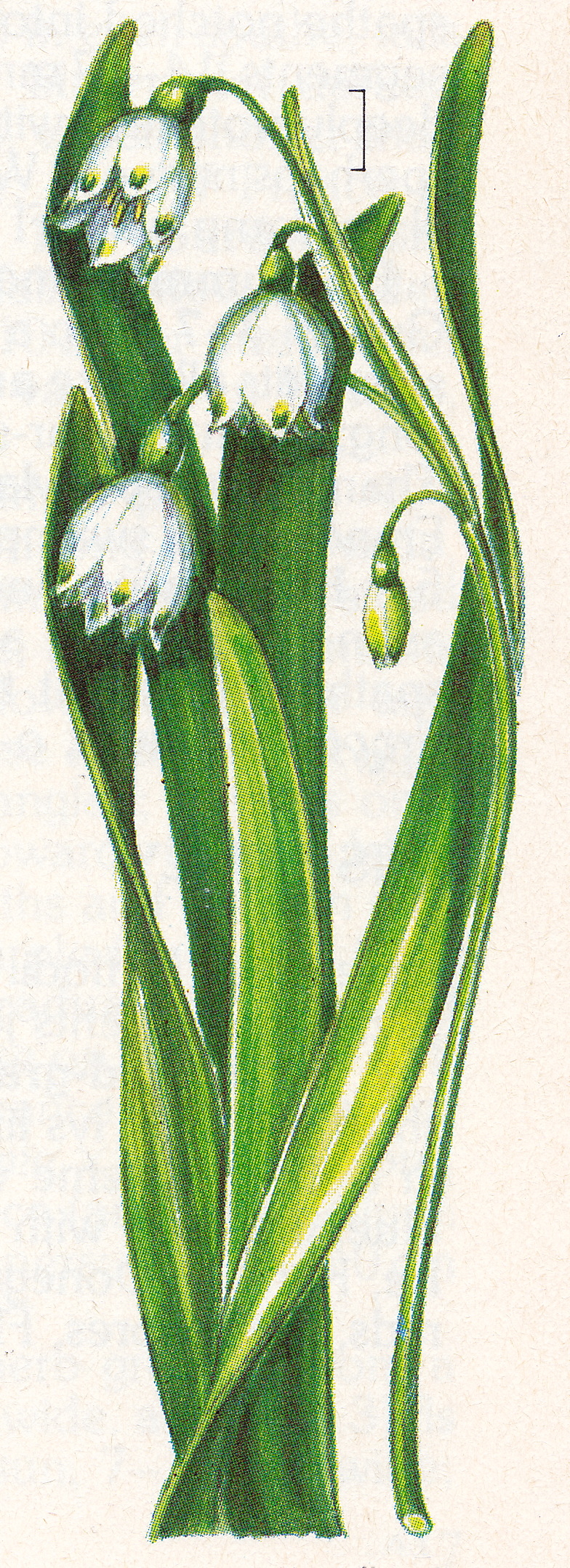sab·sab (sab´sab) n. in the tales of Pern, an herb found growing upon hillsides near Bitra hold, and whose ground roots produce a yellow pigment. [? < Sp. sabadilla (Schoenocaulon officinale A.Gray, of the Melanthiaceae); or alternatively ? < NL Sabsab Adans., a grass genus now part of Paspalum L., of the Poaceae]
sac (sak) n. a pouch or bag-shaped organ of a plant or fungus. [< F < L saccus sack]
saint Dabeoc’s heath n. either of the species of the genus Daboecia D.Don (especially D. cantabrica (Huds.) K.Koch, of the Ericaceae), which are upright heaths growing on cliffs and rocks in coastal Ireland, France, Iberia, and the Azores; Irish heath. [< Irish saint Dabheog (5th c.), patron saint of Lough Derg]
sal·low (sal´ō) n. Brit. willow, particularly Salix caprea L. (of the Salicaceae), a shrub or small tree native to Europe, and bearing large ovate leaves and fluffy catkins; goat willow. [< OE salh < Gmc., akin to Ir. saileach] —sal´low·y, adj.
salt·wort (sält´wôrt´) n. an herb genus of seashores and salt plains (Salsola L., of the Chenopodiaceae), whose tissues – when burned – are a rich source of alkali ash.
sam·phire (sam´fīr´) n. 1 an herbal genus (Salicornia L., of the Chenopodiaceae), bearing succulent scale leaves, and whose tissues are burned as a rich source of ash in glassmaking; glasswort. 2 an herb native to Europe (Crithmum maritimum L., of the Apiaceae), which grows along rocky seacoasts. [< ME sampiere < F (herbe de) Saint Pierre]
san·da·rac (san´də rak´) n. 1 a resin, produced by the arar-tree, which has been of use in manuscript production, in perfumery, in medicine, and as a fixative in microscopy and in the arts; gum sandarac. 2 arar-tree. 3 the dark aromatic wood of this tree. [< ME sandaracha < L sandaraca < Gk. sandarákē σανδαράκη beebread]
sap·ro·bi·ont (sap´rō bī´ont) an organism that lives on and derives nourishment from decaying organic matter; heterophyte; saprophyte. [NL < Gk. sapros σαπρός rotten + bíos βίος life + ontos ὄντος a being]
scab·wort (skab´wôrt) n. a tall herb (Inula helenium L., of the Asteraceae) native to boreal Europe and Asia, and now naturalized in North America also; elecampane; elf dock. It frequently grows in loam at the edge of woods, easily reaching 1.5m in height, and bearing multiple large bright yellow capitula at its apex. It has a variety of uses in medicine and also as a confection. [< ME scab (< ON skabbr, akin to OE sceabb) + OE wyrt]
scallop squash n. cymling; pattypan.
scan·dent (skan´dənt) adj. having a climbing habit. [< L scandens climbing]
sca·pose (skā´pōs´) adj. an herbal growth form lacking a leafy aerial axis, aerial stems (where present) providing only for the growth of flowers; acaulescent. [< L scāpus stalk + -osus prone to]
scar·i·fy (skär´ə fī´) v.t. make scratches in a surface, such as a seed coat , or harrow a plot of farmland. [ME < OF scarifier < LL < Gk. skariphasthai σκαριφασθαι scratch an outline] —scar´i·fi·ca´tion, n.
schil·tron (shil´tron) n. a mediæval army formation, quadrangular or circular, in which the soldiers utilize 4m pikes either as protection against cavalry charges or as an offensive weapon. [OE]
schopf·baum (shopf´boum) n. any plant which grows as a single unbranched woody trunk, up to a height of 10m, bearing leaves (usually large) in a rosette at the apex. [< G schopfbaum < schopf tuft + baum tree]
scratch·bush (skrach´bu̇sh) n. any of numerous species of the genus Urera Gaudich. (of the Urticaceae), shrubs or small trees very closely-related to the nettles, and growing natively in various tropical and subtropical locations. All bear urticating hairs upon their leaves.
scrub·land (skrub ´land´) n. a shrubby landscape, without taller vegetation; shrubland.
scur·vy·grass (skėr´vē gras´) n. any of the various species of genus Cochlearia L. (of the Brassicaceae), herbs bearing small white flowers and somewhat sarcous leaves, and frequently-found in seaside or alpine habitats. [C. officinalis L. was previously used as a remedy for scurvy]
sea·blite (sē´blīt) n. any of the several species of Suaeda Forssk. ex J.F.Gmel. (of the Chenopodiaceae), halophytes native to seashore and salt lake shores as well as desert and alpine habitats, and bearing succulent foliage; blite.
sea-milkwort n. a creeping perennial herb common to boreal temperate seacoasts (Glaux maritima L., of the Primulaceae), bearing small pink 5-merous flowers which somewhat suggest those of milkwort.
sec·a·teurs (sek´ə tərz´) n.pl. a small pruning implement consisting of two blades with finger holes, rather like scissors, used to trim garden plants. [< F sécateur cutter < L secare to cut]
seed tray n. a shallow flat tray in which seeds may be germinated. It is large enough to allow sufficient distance between seeds, and bears small holes or channels in its base to allow water to enter. It is filled with a small amount of fine soil as a bedding medium.
self·heal (self´hēl´) n. perennial rhizomatous herbs (species of Prunella L., of the Lamiaceae), bearing purple flowers in a compact apical cymose head. [previously used as a quick treatment for wounds]
sel·va (sel´və) n. land which is covered by climax tropical rainforest. [< Port. < L silva forest]
sem·el·par·i·ty (sem´əl pãr´i tē) n. the production of fruit a single time before dying; hapaxanthy; monocarpy. [< Gk. Semelé Σεμέλη earth goddess, mother (by Zeus) of Dionysus + L pareo bring forth, beget + Fr. -ité (< L -itas noun suffix)] —sem´el·par´ous, adj.
sem·o·li·na (sem´o lē´nə) n. the granular endosperm of crushed durum wheat grains, sometimes collected to be steamed, as an ingredient of the steamed grain dish couscous, or to be ground for preparation of pasta. [< Ital. semolino < semola bran + -ino diminutive < L simila very fine flour; ? < Assyrian samidu fine meal]
se·pal·oid (sep´əl oid´) adj. of petals, retaining or exhibiting features of sepals. [< NL sepalum separate petal + -oides, a contraction of Gk. -eidos -εἶδος a thing that is like]
sept·foil (set´foil´) n. 1 a perennial subshrub native to temperate Eurasia (Potentilla erecta (L.) Raeusch., of the Rosaceae), growing from a stout woody rhizome and bearing palmately compound leaves of three to five (and, occasionally, seven) pinnæ; bloodroot; tormentil. The rhizome produces a red dye, and the flowers each bear four obcordate yellow petals. 2 in architecture, an ornamental carving or foliation consisting of seven arcs joined by seven cusps, arranged around a centre, used in windows, panels, etc. [< AF sept seven + foil leaf < L septifolium < septem seven + folium leaf]
ser·ra·del·la (se´rä del´ə) n. a prostrate sericeous annual (Ornithopus L., of the Fabaceae: Papilionoideae), present in sandy soils of Europe, north Africa, and with one species in South America; bird’s-foot. [Ital. serradella diminutive saw]
shade (shād) adj. of a plant, capable of growth while avoiding exposure to direct sunlight, or preferring growth under or sheltered by other plants or structures. Depending upon context, this may specifically apply to the preferences of the plant when flowering or fruiting.
shale (shāl) n. v. —n. the shell or husk of a fruit, usually a nut but also sometimes the legume of peas or beans. —v.t. remove (seeds) from their husk or pod. —v. of individual fruits, allow seeds to fall. [< ME schale husk, pod < OE scealu < ON skál scale]
sham·rock (sham´rok´) n. any of several low-growing trifoliate members of the clover genus Trifolium L. (especially T. dubium Sibth., of the Fabaceae: Papilionoideae), native to Europe and bearing yellow flowers. T. dubium Sibth. is regarded as the national flower of Ireland. [< Ir. seamróg trefoil < seamar clover + -og young]
she-oak (shē´ōk´) n. 1 any of the shrubs or trees currently comprising the familia Casuarinaceae, native to the region of Australasia, bearing photosynthetic ultimate branchlets with whorls of leaves reduced to scales at their many nodes; beefwood; ironwood. Its fruits are samaroid nuts, borne from dense spikes of female flowers. 2 the wood of these species.
shepherd’s cress n. either of a couple of low annual or biennial herbs (Teesdalia nudicaulis (L.) W.T.Aiton and T. coronopifolia (J.P.Bergeret) Thell., both of the Brassicaceae) consisting of a basal rosette of pinnatilobate leaves with a large distal lobe, and one or two naked ascending flowering stems, growing as ruderals on dry ground, but avoiding chalk.
shi·i·ta·ke (shē´ē tä ke) n. a cultivated edible mushroom (Lentinula edodes (Berk.) Pegler, of the Basidiomycota), growing natively in China, Korea, and Japan upon fallen wood, and much appreciated for its rich delicate flavour. It also has several medicinal uses, but can cause dermatitis in some. [< J. 椎茸 < 椎 (shii) the Japanese chinquapin tree + 茸 (take) mushroom]
shrub·land (shrub ´lənd) n. a shrubby landscape, without taller vegetation; scrubland.
skeel (skēl) n. in the novel Gods of Mars by Edgar Rice Burroughs, a lofty hardwood of Barsoom (Mars), much used for durable woodwork. [Barsoomian]
slip·per·wort (slip´ər wôrt´) n. any of numerous tropical American herbs of the genus Calceolaria L. (of the Scrophulariaceae), logically bearing calceolate flowers.
snag (snag) n. 1 a dead tree which remains standing, particularly used of conifers. 2 a submerged portion of timber which impedes navigation.
snake·head (snāk´hed) n. any plant of the genus Chelone L. (of the Scrophulariaceae); turtlehead.
snake·weed (snāk´wēd) n. bistort; adderwort.
sneeze·weed (snēz´wēd´) n. any coarse herb of the largely North American genus Helenium L. (of the Asteraceae), chiefly perennials bearing showy capitula, and whose florets may induce sneezing.
sneeze·wood (snēz´wu̇d´) n. 1 any of a small genus of trees native to southern Africa (Ptaeroxylon Eckl. & Zeyh., of the Ptaeroxylaceae). 2 the dense wood of these trees, which – when ground to powder – may induce sneezing and has a peppery smell; neishout.
sneeze·wort (snēz´wôrt´) n. a yarrow native to Eurasia (Achillea ptarmica L., of the Asteraceae), whose leaves induce sneezing when dried and ground.
snow·drop (snō´drop) n. an herb native to Europe (Galanthus nivalis L., of the Amaryllidaceae), which is much cultivated for its attractive and early pendent white campanulate flowers with green markings. It grows from a bulb.
snow·flake (snō´flāk´) n. any of an Eurasian herbal genus (Leucojum L., of the Amaryllidaceae), bearing pendant white flowers somewhat suggesting those of snowdrop, but more urceolate.
solar furnace n. in botany, a minute furnace comprising a pistil or carpellate whorl at the focus of a parametric dish of petals (which are usually white), enabling warmer temperatures to be attained in sunlight while seeds are fertilized and mature. Certain arctic and alpine plant species bear flowers in the nature of a solar furnace.
som·pus (sōm´püs) n. in the novel Thuvia Maid of Mars by Edgar Rice Burroughs, a tree native to Barsoom (Mars), bearing edible fruit resembling a red grapefruit. [Barsoomian]
son·ra·i (sōn rä´ē) n. in the novel Tigana by Guy Gavriel Kay, a shrub which grows upon Mt. Sangarios on the island of Chiara, and which bears blood-red berries in clusters. The berries are intoxicating.
so·ra·pus (sō´rə püs´) n. in the novel Gods of Mars by Edgar Rice Burroughs, a hardwood tree of Barsoom (Mars), providing wood useful to fabrication, and bearing as fruit a large succulent nut. [Barsoomian]
sor·rel (sôr´əl) n. any of a number of species of the genus Rumex L. (principally the European R. acetosa L. and R. scutatus L. of the Polygonaceae) which are used in salads and cooking for their acidic leaves; dock. [ME < OF sorele sour < Gmc.]
soy·lent (soi´lənt) n. 1 in the novel Make Room, Make Room!, by Harry Harrison, an artificial food substitute which is confected from raw ingredients, in a world where natural plants and animals have been exterminated. 2 a food preparation, various recipes of which are available on the internet, but which is basically a mixture of multivitamins, fibre, various minerals, carbohydrates, protein, and served in soy milk. [< E soybean + lentil]
spear·wort (spēr´wôrt) n. any of several species of the genus Ranunculus L. (especially R. flammula L., R. ophioglossifolius Vill., R. reptans L., R. lingua L., and R. x levenensis Druce ex Gornall, all of the Ranunculaceae), bearing simple lanceolate leaves, and native to fens, marshes, or wet muds in temperate Eurasia.
spec·i·fi·er (spes´ə fī´ər) n. with reference to PhyloCode, a species, specimen, or (in some cases) an apomorphy which is cited as a reference point in a phylogenetic definition of a name for a clade. [< OF specifier]
spec·i·men (spes´ə min´) n. 1 an individual organism employed as a representative of its species or type for scientific study. 2 in reference to PhyloCode, a typus. [< L specimen proof, model < specere look at]
sper·ma·ti·um (spėr mat´ē əm) n. -ti·a. 1 a male nonmotile reproductive spore borne by certain Ascomycota and fungi imperfecti, including those in lichens, upon a pycnidium; pycnidiospore. 2 a male nonmotile gamete of algae of divisio Rhodophycophyta, borne upon a spermogonium. [NL < Gk. spermátion σπερμάτιον < spermatos σπέρματος seed + -ion -ιον diminutive suffix]
sper·ma·to- (spər mat´ō) comb.form., prefix. 1 seed. 2 sperm. [< Gk. spermatos σπέρματος seed]
sper·mat·o·zo·id (spər mat´ə zō´id) n. a mature male sex cell, found in certain algæ, bryophytes, and gymnosperms, which is motile; antherozoid. [NL < Gk. spermatos σπέρματος seed + -zoid -ζῶιδ animalcule (< zōon ζῶον animal + -idion -ΐδιον diminutive)]
spice·bush (spīs´bu̇sh) n. any of several aromatic shrubs of the genera Calycanthus L. (of the Calycanthaceae) or Lindera Thunb. (of the Lauraceae), largely those native to North America, and bearing glabrous obovate or oblanceolate leaves. Several have been used as a source of spice from their bark or fruit.
spi·der (spī´dər) n. among the daylilies, a plant exhibiting flower morphology in which the petals and sepals show a length-to-width ratio of at least 4:1.
spin·dle (spin´dəl) n. 1 a slender formation of microtubules which forms within cells of many (but not all) eukaryotic species at cell division, and to which the centromeres of chromosomes attach and are collectively drawn to opposite ends of the dividing cell. 2 spindle tree. [< OE spinel]
spi·nes·cent (spī nes´ənt) adj. 1 growing to resemble a spine. 2 terminating in a spine. 3 spinose. [< LL spīnēscēns growing thorny < L spina, originally, thorn + -escens, -escentis beginning, slightly] —spi·nes´cence, n.
spin·ney (spin´ē) n. -neys. a small grouping of trees and shrubs. [ME < OF espinei < L spinetum thicket]
splin·ter (splin´tər) v.i. n. —v.i. splin·tered, splin·ter·ing. break or fracture into small – often sharp – oblong pieces or fragments. —n. such a pointed fragment of wood. [ME < MDu.] —splin´ter·y, adj.
spoil (spoil) v.i. spoiled or spoilt, spoil·ing. of a plant or of its flowers or fruit, become diseased or decay to the point of being no longer useful. [ME < OF espoillier < L spoliare plunder]
spoil·age (spoi´lij) n. 1 decay, usually used in reference to harvested flowers, fruits, and plants. 2 the waste matter deriving from such decay. [< ME spoil + -age process, outcome of]
spo·ro·carp (spô´rə kärp´) n. 1 a specialised organ upon fronds of the aquatic ferns comprising orden Salviniales Bartl. in Mart., which encloses the sori. 2 a generalised term for spore-generating organs encountered in certain fungi, algæ, and lichens. [NL < Gk. spora σπορά seed + karpos καρπος fruit]
spo·ro·derm (spô´rə dėrm´) n. the cell wall and associated structures which protect spores upon release from their parent organism. The wall may be structurally divided into layers such as the intine and exine, as well as perine and filosum in some cases. [NL < Gk. spora σπορά seed + derma δέρμα skin]
spor·u·late (spôr´ū lāt´) v.i. to actively generate spores. [NL < Gk. spora σπορά seed + L -ula diminutive + -ātus verbal suffix] —spor´u·la´tion, n.
spud (spəd) n. 1 Informal. a potato (rhizome). 2 a small, narrow spade used for cutting roots of weeds. 3 a tool resembling a chisel, often used for removing tree bark. 4 Slang. vodka. —v.t. use a spud to eradicate (weeds) or remove (bark). [ME spudde a short knife]
star·flow·er (stär´flou´ėr) n. any of a number of species which generate flowers suggestive of stars in the sky – among them the species named star-of-Bethlehem, as well as species of Trientalis Rupp. ex L. (of the Primulaceae).
star·lights (stär´līts´) n. a low cranesbill of northern Eurasia (Geranium molle L. of the Geraniaceae), bearing light-purple flowers; culverfoot; dove’s-foot; jam-tarts.
star-of-Bethlehem n. any of a large number of herbal species of the white-flowered Ornithogalum L. (of the Hyacinthaceae) and the yellow-flowered Gagea Salisb. (of the Liliaceae), both of which bear striking flowers among upright linear leaves, and are native to central Europe, western Asia, and southern Africa. Both are now cultivated for their flowers.
star-tulip n. a subset of species of the North American genus Calochortus Pursh (of the Liliaceae), which tend to generate flowers with erect acute petals, and to grow in wet meadows.
steep (stēp) v.t. soak leaves or other plant parts in hot water, in order to extract flavour and effective ingredients from them and constitute a beverage, or to soften them. [ME < Gmc.]
ste·no·hy·drous (ste´nō hī´drəs) adj. of an organism, having a restricted range of hydration within which it can survive. [NL < Gk. stenos στενός narrow + hýdōr ὕδωρ water + L -osus prone to]
sto·ma·tif·er·ous (stō´mə tif´ər əs) adj. possessing or capable of forming stomata.
strap·wort (strap´wôrt) n. a branching prostrate annual herb native to northern Europe (Corrigiola litoralis L, of the Molluginaceae), growing on sandy or gravelly shores of intermittently-flooded lakeshores. Its minute flowers are coloured a mixture of white, green, and red.
straw pipe n. the hollow stem or stalk of grass, when employed in handicrafts, to distinguish the hollow portion from the solid node. [descriptive]
stress (stres) n. v.t. —n. a suffering from lack of appropriate levels in one or several required resources. —v.t. 1 subject an organism to inappropriate levels of particular resources which it requires. 2 give emphasis to a particular point in a report. [ME abbrev. of distress < OF estresse narrowness, oppression < L strictus tight, close] —stres´sor, n.
stro·bi·loid (strō´bi loid´) adj. of a flower, an architecture in which there is an elongate axis, cylindrical or tending towards spherical or flattened, with floral envelope and then androecia and/or gynoecia succeeding towards the apex. [NL < Gk. stróbīlos στρόβιλος pine cone, whirlwind, whirling dance (< stróbos στρόβος whirling around) + -eidos -εἶδος form]
stro·bi·lus (strō´bi ləs) n. -bi·li. 1 a reproductive cone-like structure composed of sporophylls, as of the club mosses, horsetails, cycads, and pinophytes. The sporophylls are generally in an overlapping or spiral arrangement along the axis of the strobilus. 2 an infructescence in which many floral bracts are arranged in an overlapping fashion, as in the hop plant. [NL < Gk. stróbīlos στρόβιλος pine cone, whirlwind, whirling dance < stróbos στρόβος whirling around] —stro´bi·lar´, adj.
stub (stəb) n. v.t. —n. 1 a plant’s rooted remains, such as following a harvesting by cutting, or a broken treetrunk; stump. 2 a similar projecting remnant of a plant organ, such as a remnant minor branch upon a major branch; stump. —v.t. 1 dig up the roots of a plant. 2 clear (an area of land) of stubs; stump. [OE stubb stump of a tree < Gmc.] —stubbed, adj.
stub·ber (stə´bėr) n. one who stubs a plant, or an area of ground.
stub·ble (stə´bəl) n. 1 the stalks of cultivated crops which remain rooted in the ground following harvest. 2 any short rough growth. [< ME < AF stuble < VL stupla, stupula < L stipula stalk, stipule] —stub´bled, adj. —stub´bly, adj.
stump (stəmp) n. v.t. —n. 1 the bottom of a tree trunk, just above the root crown, which remains after a tree breaks its trunk or is cut; stub. 2 a similar projecting remnant of a plant organ, such as a remnant minor branch upon a major branch; stub. —v.t. 1 reduce to a stump, truncate. 2 clear (an area of land) of stumps; stub. [ME stompe < MDu. stomp; there is evidence of an obs. OE verb related to tripping (or stumbling) over an exposed stump]
stump farm n. in Canada, used of farms or ranches established in undeveloped terrain in which crops are planted – or animals graze – among remnant tree stumps.
stump ranch n. in British Columbia, used of ranches with undeveloped terrain in which animals graze among remnant tree stumps; stump farm.
stunt (stənt) v.t. retard the growth or development of an individual or organ.
stunt·ed (stən´tid) adj. of an individual or organ, imperfectly developed or smaller than normal; depauperate. [< dial. stunt foolish, stubborn < Gmc.] —stunt´ed·ness, n.
sty·lo·po·di·um (stī´lə pō´dē əm) n. -di·a. a notable discoid enation surmounting the ovary in many genera of familia Apiaceae, and bearing the style(s). [NL < Gk. stylos στῦλος column + podion πόδῖον a small foot]
suc·ceed (sək sēd´) v.i. thrive, prosper, grow well. —v.t. of an individual plant or of a community, come after and supplant. [< ME succeden < OF succeder < L succēdere come close after]
suc·ceed·ing (sək sē´ding) adj. of or referring to that which follows.
suc·ces·sion (suk sesh´ən) n. 1 in synecology, the process whereby an individual or a community appears upon the previous existence of necessary precursors and habitat characteristics. 2 the entire sequence of species which this succession comprises. [< L successionis successors < succēdere come close after] —suc·ces´sion·al, adj. —suc·ces´sion·al·ly, adv.
suc·cu·bous (suk´yə bəs) adj. of a leafy liverwort, bearing microphylls inserted obliquely upon the stem in such a manner that their apex is covered by the proximal end of the next superior microphyll. [NL < LL succubare lie under + OF -ous full of]
sun (sun) adj. of a plant, capable of growth while exposed to direct sunlight. Depending upon context, this may specifically apply to the preferences of the plant when flowering or fruiting.
sunken garden n. a garden whose level surfaces are set at a level below that of the surrounding lands.
sun-spurge n. the northern Eurasian Euphorbia helioscopia L. (of the Euphorbiaceae), an annual ruderal species notable for its acrid latex, which is used in medicine; wolf’s-milk.
su·per·posed (sü´per pōzd´) adj. of buds, when the normal single bud at a leaf base is joined by a second placed immediately distal and axillary to it, the second bud is called superposed. [< F superposer]
sup·plant (sə plant´) v.t. supercede and replace. [< ME supplanten < OF supplanter < L supplantāre trip up, overthrow < sub- from below + planta sole of foot] —sup´plan·ta´tion, n.
su·pra·fi·lo·sum (sü´prə fī´lō´süm) n. -sa. in ferns of suborder Hydropteridineae Rothwell & Stockey, a distinct layer to the outer megaspore exoperine, consisting of abundant fine hairs which are generated upon the surface of the collar itself, or the columella which may extend to hydrodynamic floats. [< L supra above + filum thread + -ōsum augmented, prone to]
su·pra·spore (sü´prə spôr´) n. in ferns of suborder Hydropteridineae Rothwell & Stockey, that portion of the megaspore which constitutes the swimming apparatus or buoyancy enations of the spore body. [NL < L supra above + Gk. spora σπορά seed]
Swamp Thing n. in certain graphic novels published by DC Comics, a character presented either as a shambling “vegetable-like creature” or as an “elemental entity”, which arises from swamp and essentially acts as a human with good intentions while never being accepted as a human. The character was devised by writer Len Wein in 1971.
syn·an·the·ra (sin an´thə rə) n. -rae. any member of familia Asteraceae, or possibly additionally of the Aizoaceae. [< NL Synantheræ < Gk. syn- συν- together + anthēra ἀνθηρά, fem. of anthēros ἀνθηρός flowery]
syn·an·throse (sin an´thrōs) n. an isomer of sucrose, found in representatives of familia Asteraceae. [< NL Synantheræ composites + F -ose suffix indicating sugar]
syn·ste·mo·nous (sin ste´mə nəs) adj. of a flower, producing stamens which unite or adhere to each other, either partially or completely. [< Gk. syn- συν- together + stemōnas στημόνας thread, stamen + L -ōsus pertaining to, prone to]




